Click on images to enlarge
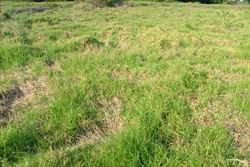
large infestation (Photo: Sheldon Navie)
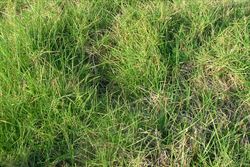
habit of dense population (Photo: Sheldon Navie)
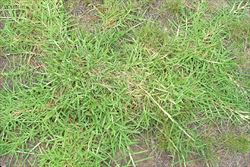
creeping habit when colonising a bare area (Photo: Sheldon Navie)
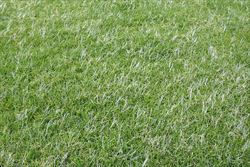
habit in flower when being grown as a lawn (Photo: Sheldon Navie)
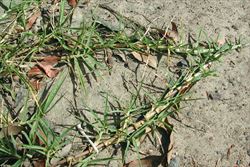
creeping stems (Photo: Sheldon Navie)
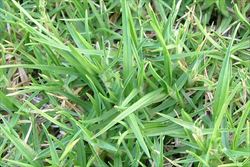
leaves (Photo: Sheldon Navie)
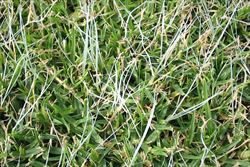
flowers (Photo: Sheldon Navie)

close-up of leaves and feathery stigmas (Photo: Sheldon Navie)
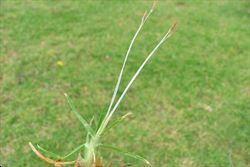
close-up of very long stamens (Photo: Sheldon Navie)
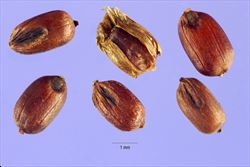
close-up of seeds (Photo: Steve Hurst at USDA PLANTS Database)
Scientific Name
Cenchrus clandestinus (Hochst. ex Chiov.) Morrone
Synonyms
Pennisetum clandestinum Hochst. ex Chiov.
Family
Gramineae (South Australia)Poaceae (Queensland, New South Wales, the ACT, Victoria, Tasmania, Western Australia and the Northern Territory)
Common Names
kikuyu, kikuyu grass, kikuyugrass
Origin
Native to tropical eastern and central Africa (i.e. Ethiopia, Kenya, Tanzania, Uganda, Burundi, Rwanda and Zaire).
Cultivation
Originally introduced as a lawn and pasture grass, and still used for these purposes.
Naturalised Distribution
Widely naturalised southern and eastern Australia (i.e. in southern and central Queensland, eastern New South Wales, the ACT, Victoria, Tasmania, many parts of South Australia and south-western Western Australia). Also occasionally naturalised in the southern parts of the Northern Territory and naturalised on Lord Howe Island and Norfolk Island.
Also widely naturalised in other parts of the world, including in northern and southern Africa, China, tropical Asia (i.e. India, Sri Lanka, Taiwan, Papua New Guinea, the Philippines and Indonesia), New Zealand, south-western USA, Mexico, Central America (e.g. Costa Rica), South America (e.g. Colombia, Peru and Ecuador), La Réunion, and numerous Pacific islands (e.g. the Galapagos Islands, Melanesia, Polynesia and Hawaii).
Habitat
A weed of closed forests, open woodlands, grasslands, riparian areas, disturbed sites, waste areas, orchards, crops, lawns, gardens, footpaths and parks in sub-tropical and temperate regions.
Habit
A long-lived (i.e. perennial) mat-forming grass with short coarse leaves and horizontal creeping stems (i.e. stolons) with many joints (i.e. nodes). It generally grows less than 30 cm in height, but may occasionally reach up to 90 cm tall.
Distinguishing Features
- a long-lived grass with creeping stems that form dense mats of vegetation.
- its leaves are short and become coarse-textured with age.
- its small seed-heads remain hidden within the leaf sheaths and seeds are rarely formed.
Stems and Leaves
Plants are a network of horizontal many-jointed stems (i.e. stolons) forming dense mats on the soil surface. Creeping underground stems (i.e. rhizomes) are also produced.
The leaves consist of a leaf sheath at the base, which encloses the stem, and a spreading leaf blade. They are often relatively short (1-30 cm long and 3-7 mm wide) and either hairless (i.e. glabrous) or with a sparse to dense covering of hairs with swollen bases (i.e. tuberculose hairs). At the junction of the leaf sheath and leaf blade is a small line of hairs (i.e. ciliate ligule). The leaves are folded at first, then they flatten out become coarser in texture as they mature.
Flowers and Fruit
The seed-heads are usually inconspicuous, remaining hidden inside the sheaths of the leaves. However, small branched seed-heads may occasionally emerge from inside the sheath of the upper leaves. These seed-heads consist of a cluster of 2-4 logn and narrow (i.e. lanceolate) flower spikelets. These spikelets (10-20 mm long and 0.8-1.5 mm wide) may contain either bisexual flowers, male flowers or female flowers. Each flower spikelet is subtended by a ring of bristles. Bisexual and female flowers have long two-branched stigmas that emerge from the leaf sheath, while bisexual and male flowers have three very long stamens borne on filaments 2.5-5 cm long. Flowering occurs mostly during summer.
This species only set seed under certain conditions. The 'seeds' (i.e. caryopses or grains) are oblong in shape (2-3 mm long), somewhat flattened and dark reddish-brown in colour.
Reproduction and Dispersal
Kikuyu (Cenchrus clandestinus) most commonly spreads vegetatively via its creeping aboveground and belowground stems (i.e. stolons and rhizomes). It sometimes also reproduces by seed.
Environmental Impact
Kikuyu (Cenchrus clandestinus) is regarded as an environmental weed in Victoria, South Australia, Western Australia, New South Wales and Queensland.
Legislation
Not declared or considered noxious by any state government authorities.

